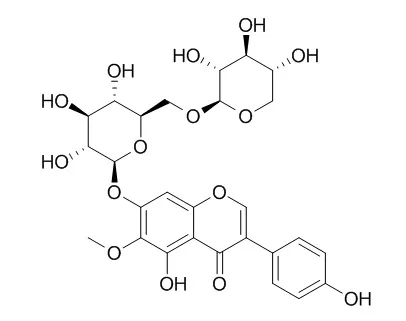| Structure Identification: |
| Bioscience and Microflora, 2011, 30(4):135-140. | | Metabolism of Isoflavones Found in the Pueraria thomsonii Flower by Human Intestinal Microbiota.[Pubmed: 25045319] | Isoflavones contained in the root and flower of Kudzu (Pueraria lobata and related species) are suggested to be the critical component for its effects. Although metabolism of soy isoflavones has been well studied, the composition of isoflavones found in Kudzu is completely different from that of soy isoflavones.
METHODS AND RESULTS:
In the present study, we investigated whether isoflavones found in the flower of Pueraria thomsonii, a species of Kudzu, were metabolized by human fecal microbiota and murine small intestinal enzymes. Among 5 glycosidic isoflavones of the Pueraria thomsonii flower, Tectorigenin 7-O-xylosylglucoside, tectoridin, genistin and glycitin were completely hydrolyzed by a homogenate of germfree mouse small intestine without contribution of bacteria. Released aglycones were not further metabolized, except that up to half of glycitein disappeared. Mouse small intestinal enzymes did not metabolize 6-hydroxygenistein 6,7-di-O-glucoside. Isoflavone aglycones as well as 6-hydroxygenistein 6,7-di-O-glucoside were highly metabolized by most of the human fecal suspensions.
CONCLUSIONS:
Metabolites were not detected with the present analytical methods in most cases. Although further investigations of the pharmacokinetics of Pueraria thomsonii flower isoflavones are needed, the results of the present study indicate active metabolism of Pueraria thomsonii flower isoflavones in the human intestine. |
|






 Cell. 2018 Jan 11;172(1-2):249-261.e12. doi: 10.1016/j.cell.2017.12.019.IF=36.216(2019)
Cell. 2018 Jan 11;172(1-2):249-261.e12. doi: 10.1016/j.cell.2017.12.019.IF=36.216(2019) Cell Metab. 2020 Mar 3;31(3):534-548.e5. doi: 10.1016/j.cmet.2020.01.002.IF=22.415(2019)
Cell Metab. 2020 Mar 3;31(3):534-548.e5. doi: 10.1016/j.cmet.2020.01.002.IF=22.415(2019) Mol Cell. 2017 Nov 16;68(4):673-685.e6. doi: 10.1016/j.molcel.2017.10.022.IF=14.548(2019)
Mol Cell. 2017 Nov 16;68(4):673-685.e6. doi: 10.1016/j.molcel.2017.10.022.IF=14.548(2019)